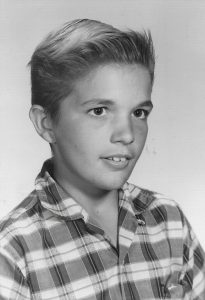The following article fist appeared in the Wednesday, May 31, 1967 edition of “The Ojai Valley News and Oaks Gazette” on Page D-6. That newspaper is now the “Ojai Valley News”. The article is reprinted here with their permission. Nick Robertson wrote the article when he was only a Junior at Happy Valley School. The photo of Robertson was placed into this article by the Ojai Valley Museum.
Marijuana more than a drug; it’s a symbol
by
Nick Robertson
Happy Valley Junior
Probably one of the most pressing problems for many people today is the question of juvenile use of drugs. Question, perhaps, is not exatly what it is though: thus far, one group has been determined to stop people from smoking marijuana and the other group has been hell-bent of getting high without getting caught. Both groups, as a matter of fact, are too busy to bother to learn anything about marijuana itself, or the other group.
At the moment, marijuana is more than just an intoxicant. For the mainstream of America, it is long hair, beards, cacophonic music, and “dropping out.” For the “hippies” and the other youth cults (call them what you will: fads, movements, games, cults. Who knows?) it is a heavy club to hold over mainstream America, somewhat comparable to a Masonic handshake or some other symbol of a closed society.
As far as I am concerned, it is a rather selfish cause, but highly understandable. To many people, middle class America is represented as much by alcohol as the hippies are by drugs, and a rebellion against middle class America is not only understandable but highly logical to youth.
But I’m straying from my end: It is time for a reevaluation of our laws concerning marijuana on one hand and a reevaluation of the use of marijuana on the other.
Its history
Let’s begin at the beginning: marijuana is the name we have for the leaves of the plant cannabis sativa meant to be smoked. The plant, also known as Indian hemp, was at one time used for rope. Hashish, a specially prepared form of the plant which looks somewhat like sen-sen, takes it name from the same root as assassin: disciples of Hassan Ben Sabah, “The Old Man of the Mountain,” who started a terrorist organization working from the mountains of Persio, got “high” before they were sent out to murder assorted people. Thus, hashish, “the gift of Hassen.”
The drug is common in the Middle East, where the Muslim religion prohibits drinking. Apparently, there is little or no problem of addiction in the hashish dens more spectacular than their equivalent of barflies.
The problem does not begin until one comes into possession of marijuana in the United States. According to the 1965 edition of Compton’s Encyclopedia, one is arrested for failing to pay the tax on marijuana (this is the federal law, bear in mind: probably designed to make the FBI eligible for work in narcotics control), or for selling narcotics without license, if sale is the charge. Though I do not know exactly what would happen were one to ask for a tax stamp, there are also state laws (though in Colorado, the charge of marijuana possession is a misdemeanor only) which make it illegal.
Effects
The effects of marijuana have been variously described as amazingly similar to alcohol (they are in essence the same, after all), an opening of doors in the mind, and even as a temporary form of paranoia. It is non-addictive, and as to charges that it leads to addiction, they have been answered by saying that this is society-induced and legalization could correct it.
Many people find absolutely no hostility when under the influence of the drug, but law enforcement agents say that someone may become dangerous when under the influence of some form of marijuana. It is said that marijuana leads to addiction, and some would even consider the drug addictive.
The numbers of people knowing, or having heard, both sides to the story is extremely small. As a matter of fact, most people are rather ignorant about the subject, yet would cheer when users are arrested simply because they are breaking the law.
The police, of course, recognize the ignorance and apathy get nowhere, and have begun programs of education for youths, parents, and teachers.
This is a step in the right direction, but with one foot only. Is there any reason why parents shouldn’t talk to some users, too? Is there an way the police could talk to the users?
Whether all this is possible is indeed a question, but I fail to see how the best interests of all can be served unless both sides are shown in a fair and just light. Of course, if indiscriminate arrest or constant use are in the best interests of all, I stand corrected. But if otherwise, there is no cure for gloating over the arrests of “pot-heads” and expelling suspected users from school, nor in groups sitting around a pipe, secure in their superiority over mainstream America.
There has obviously got to be some form of correction of our attitudes. As usual, the problem is communication, and barriers are put up by both sides. Perhaps long hair isn’t all bad, perhaps work has its spiritual and moral aspects, and little on both sides. Marijuana might be a somewhat ridiculous place to start, but everybody should be grateful for anything.
As it is, any discussion of marijuana is hampered by the association of it with rebellion on college campuses, sit-ins, marches, and youth movements: by the continued propaganda and lobbying of the all-powerful liquor industry; by the inherent evil people seem to find in things foreign and the inherent good young, or rebellious people seem to find in things forbidden.


Thanks for re-publishing, Drew
Mary Ellen,
You’re welcome!
Thank you for commenting,
— Drew
Interesting and well written.
Attitudes may have changed a little.